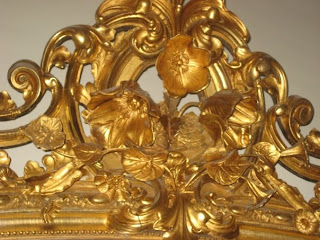Hamilton Hall built 1805
A little over a year ago I was in Salem and had a opportunity to tour Hamilton Hall a beautiful Federal building built in 1805 as a assembly hall from plans by Samuel McIntire, the renowned architect and wood carver of Salem, and was named in honor of Alexander Hamilton. A longtime gathering place for the region's cultural and social elite. The hall, named for America's first Secretary of the Treasury, Alexander Hamilton, cost $22,000 to build. In the heart of the beautiful McIntire Historic District, Chestnut Street is lined with beautiful houses, many originally built by sea captains and merchants between 1790 and 1830, during Salem’s “Great Age of Sail.”
Hamilton Hall served as the gathering place for local Federalists, the political party of wealthy ship owners. The proprietors and their invited guests attended regularly scheduled assemblies where they danced the cotillion, the minuet, and the rigadoon. At ten o'clock the attendees might troop upstairs for a brief repast prepared by the hall's legendary caterer, African American John Remond. The evening ended at exactly the stroke of midnight, often in the middle of a dance.
In its early decades Hamilton Hall was also the setting for auctions, plays, concerts, and charity fairs. Special events included a Charles Dickens Tea Party and a Leap Year Party. The latter was a 19th century version of the Sadie Hawkins dances of recent decades. Men were invited to attend by a woman, and once the dancing began the women took the lead in choosing partners.
The hall's second floor grand ballroom hosted a number of galas honoring important early-19th century political and military leaders. Among them were Salem resident and statesman Timothy Pickering, Massachusetts Gov. Christopher Gore, and William Bainbridge, commodore of the frigate Constitution.
One of Hamilton Hall's most exciting moments was a party honoring the Marquis de Lafayette during his second visit to Salem in 1824. Approximately 300 gentlemen of the town joined in toasting the beloved Frenchman in the hall which had been decorated for the occasion by their wives and other local women.
The design of the building is amazing with wonderful Federal detail. The main ballroom is known for it's spring floor,an innovation that renowned architect Samuel McIntire included to allow guests to dance for hours without undue fatigue. Large grand 1850's gold gilt Rococo Revival pier and mantel mirrors and Henry Hooper & Co gas light fixtures originally installed as gasoliers and gas flower wall brackets add a Victorian feel to the classic Federal woodwork of the building. If you are ever in Salem stop by. They are open to the public.
Gilbert du Motier, Marquis de Lafayette
The side of the building has delicate Palladian windows and carved inset panels by Samuel McIntire of a eagle and drapery festoons
The side of the building has delicate Palladian windows and carved inset panels by Samuel McIntire of a eagle
The side of the building has delicate Palladian windows and carved inset panels by Samuel McIntire of a drapery festoons
Down stairs mantel
Boston Classical server
Band stand
Grand Ballroom
1850's Rococo Revival mirror over a Federal period mantel
The grand ballroom
Rococo Revival pier mirror
Detail of mirror
late 1840's Gasolier made of gilt bronze and green and gold Boston and sandwich glass by Henry Hooper & Co of Boston. In the 19th century fresh flowers would be placed in the center green glass vase of the gasolier
late 1840's Gasolier made of gilt bronze and green and gold Boston and sandwich glass by Henry Hooper & Co of Boston. In the 19th century fresh flowers would be placed in the center green glass vase of the gasolier
late 1840's gas wall bracket in the shape of a morning glory made of gilt bronze and Boston and sandwich glass by Henry Hooper & Co of Boston.
late 1840's gas wall bracket in the shape of a morning glory made of gilt bronze and Boston and sandwich glass by Henry Hooper & Co of Boston.
Drapery tieback in the shape of a morning glory attributed to Henry Hooper & Co of Boston. The ballroom probably has tiebacks like this at one time that match the gas light fixtures
Rococo Revival mirror and gas bracket
Upstairs reception room with a pair of Boston classical sofas
Rococo Revival mirror in the Marquis de Lafayette room
Upstairs reception room with a of Boston classical sofa










































*sigh happily* The original 1805 building is just gorgeous, especially the Palladian windows, carved inset panels and the orchestra pit. In fact the entire street must have been stunning: all built between 1790 and 1830, during Salem’s golden age.
ReplyDeleteI have visited Salem, and have an overall impression of refined opulence. Sadly I have never been inside one of those homes.
But large 1850s gold gilt Rococo Revival pier & mantel mirrors, and over-the-top gas light fixtures undoubtedly came later and do not necessarily fit with the refined opulence. Finally I wonder about the wall paper - can it be dated with any certainty?
Hi The wallpaper is in the first room you walk into from the front door. I'm sure it is not original but it appears to be a copy of a American wallpaper dating from the first 25 years of the 19th century. You are right the ornate gas fixtures and mirrors don't fit in with the classic lines of the building but very few early building in American escape Victorian remolding as the Victorian period was so long. I was lucky to tour about 5 house museums in Salem it is a wonderfully preserved city.
ReplyDelete